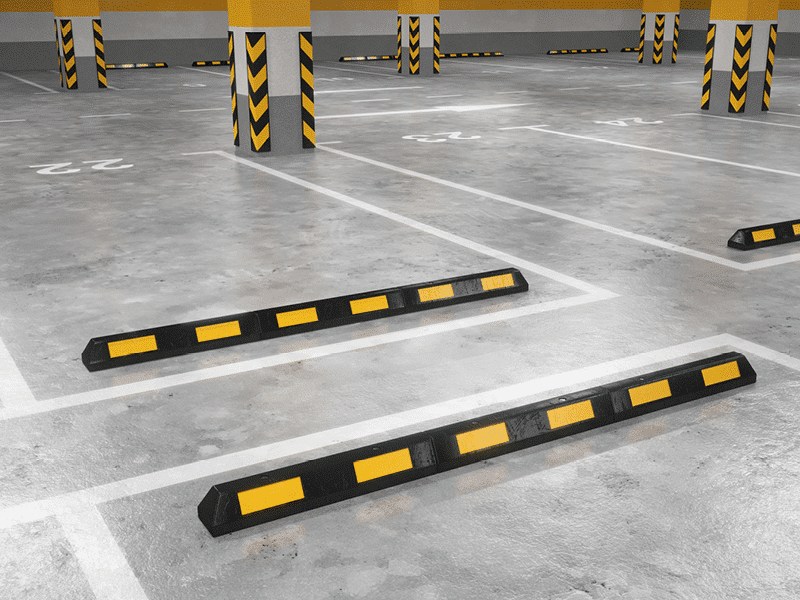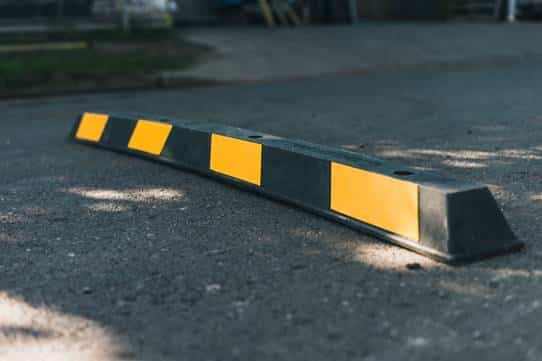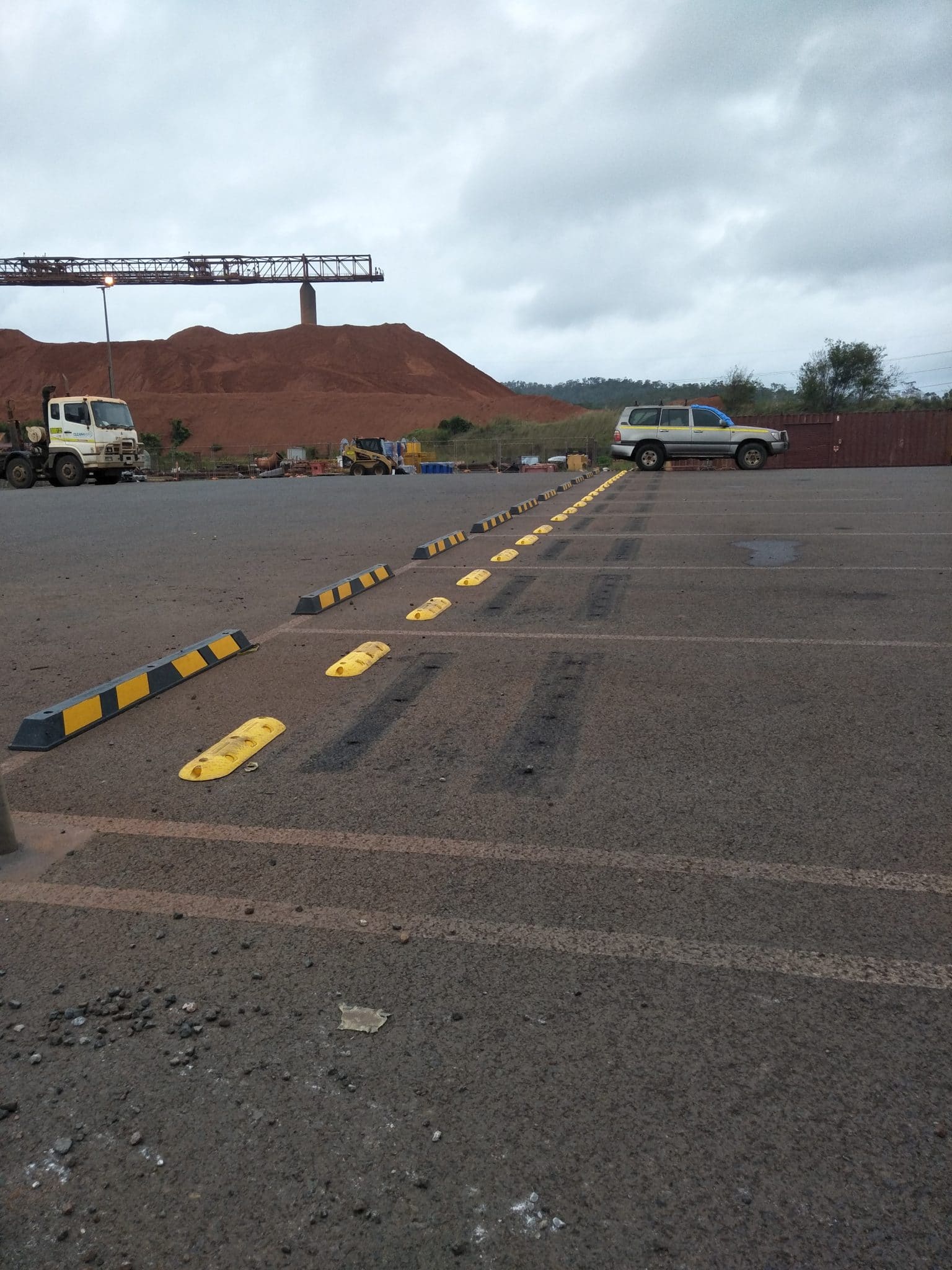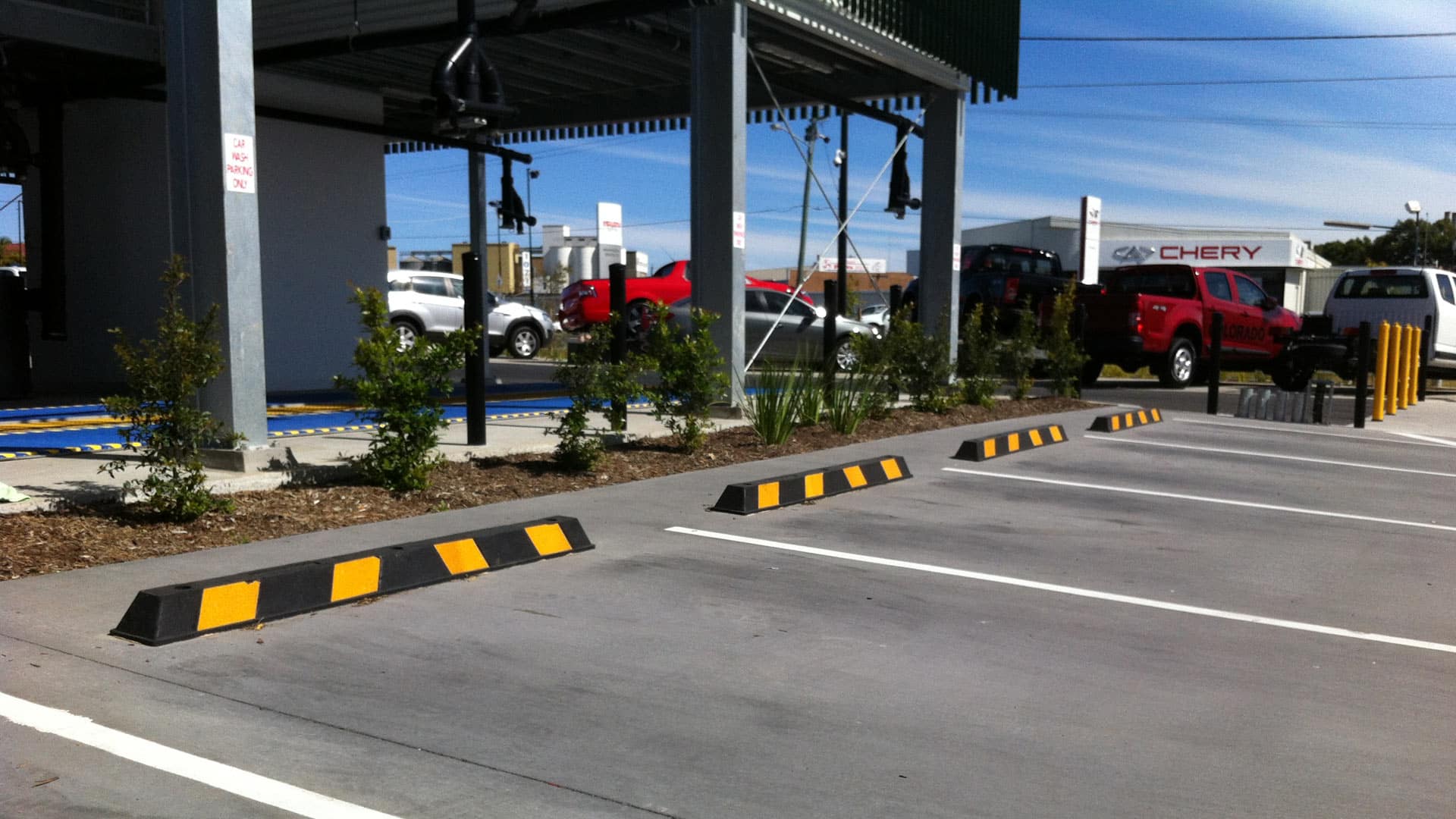Managing a property in Australia, whether it’s a bustling commercial car park, a residential complex, or an industrial site, requires careful attention to safety and organisation. One of the simplest yet most effective tools for maintaining order in parking areas is the wheel stop and choosing the best wheel stops is very important to be able to do it. These unassuming barriers play a crucial role in ensuring that vehicles park correctly, preventing them from rolling too far forward and potentially causing damage to pedestrians, buildings, or other vehicles.
 Choosing the right wheel stop for your property isn’t as straightforward as it may seem. There are various factors to consider, including material, location, compliance with Australian standards, and long-term maintenance. This guide will help you navigate these considerations, choosing the best wheel stops for your Australian property.
Choosing the right wheel stop for your property isn’t as straightforward as it may seem. There are various factors to consider, including material, location, compliance with Australian standards, and long-term maintenance. This guide will help you navigate these considerations, choosing the best wheel stops for your Australian property.
Understanding the Purpose of Wheel Stops
 Before exploring the types of wheel stops available, it’s important to understand their primary functions and why they’re essential for your property:
Before exploring the types of wheel stops available, it’s important to understand their primary functions and why they’re essential for your property:
- Protection for Pedestrians and Property: Wheel stops are designed to prevent vehicles from moving beyond a certain point, protecting pedestrians, nearby buildings, and other vehicles. This is particularly important in areas with heavy foot traffic or close proximity to structures.
- Enhancing Parking Efficiency: Wheel stops help drivers park within the designated spaces, reducing the risk of accidents and ensuring that parking areas are used efficiently. They prevent vehicles from encroaching into pedestrian walkways, reducing the likelihood of accidents.
- Compliance with Local Regulations: In Australia, many states and territories have specific guidelines regarding the installation of wheel stops, particularly in public areas. Understanding and adhering to these regulations is critical to avoid potential legal issues and ensure the safety of all users.
Selecting the Right Material for Choosing the Best Wheel Stops

Wheel stops come in various materials, each offering unique benefits and considerations. The most common materials include concrete, rubber, and plastic. Here’s a closer look at each:
- Concrete Wheel Stops:
- Durability: Concrete is known for its strength and durability, making it an ideal choice for high-traffic areas. These stops can withstand heavy loads and harsh weather conditions, making them suitable for outdoor use in commercial settings.
- Maintenance: While durable, concrete wheel stops can crack or chip over time, particularly in regions with fluctuating temperatures, particularly extreme heat. Regular inspections and maintenance are essential to ensure their longevity.
- Cost: Concrete is typically more expensive upfront than other materials, but its durability can make it a cost-effective option in the long run, especially in high-traffic areas.
- Rubber Wheel Stops:
- Environmental Benefits: Made from recycled rubber, these wheel stops are an eco-friendly option. They are also lightweight, making them easier to install and handle compared to concrete.
- Flexibility and Safety: Rubber wheel stops are less likely to cause damage to vehicles upon impact, offering a safer alternative in settings where vehicle and pedestrian traffic are in close proximity. Their flexibility allows them to withstand impacts without cracking or breaking.
- Weather Resistance: Rubber is resistant to weathering, UV rays, and chemicals, making it ideal for both indoor and outdoor use. It can endure harsh Australian weather conditions without significant wear.
- Cost-Effectiveness: While slightly more expensive than plastic, rubber wheel stops offer a good balance between durability, cost, and environmental impact.
- Plastic Wheel Stops:
- Lightweight and Versatile: Plastic wheel stops are the lightest and easiest to install. They are available in a variety of colours, which can be useful for aesthetic purposes or to enhance visibility in different environments.
- Cost Considerations: Plastic wheel stops are typically the most affordable option. However, they may not be as durable as concrete or rubber, particularly in high-traffic areas.
- Limited Durability: In areas with heavy traffic or frequent exposure to harsh weather conditions, plastic wheel stops may degrade faster, leading to higher replacement costs over time.
Environmental and Location Considerations
 The environment and specific location of your property will heavily influence your choice of wheel stops. Here’s what to consider:
The environment and specific location of your property will heavily influence your choice of wheel stops. Here’s what to consider:
- Indoor vs. Outdoor Use: The location where the wheel stops will be installed is a major factor. For indoor parking facilities or garages, lighter materials like plastic might be sufficient. However, for outdoor settings exposed to the elements, more durable materials like concrete or weather-resistant rubber are preferable.
- Climate and Weather Conditions: In Australia, different regions experience varying climate conditions, from the scorching heat in the Northern Territory to the cooler, wetter climates in Tasmania. In areas prone to extreme weather, UV-resistant and water-resistant materials should be prioritised to ensure the longevity of the wheel stops.
- Traffic Volume: The volume of traffic in your parking area is another crucial consideration. High-traffic areas, such as commercial car parks or busy retail centres, require more robust wheel stops that can withstand frequent use. Concrete or heavy-duty rubber stops are typically more suitable for these environments. In contrast, lower-traffic areas, such as residential complexes, might benefit from rubber or plastic options, which offer sufficient protection with less wear and tear.
Compliance with Australian Standards

Compliance with local regulations is non-negotiable, especially when it comes to safety features like wheel stops. In Australia, the design and installation of wheel stops must comply with the Australian Standard AS 2890.1. This standard outlines the requirements for off-street parking facilities, including the following key points:
- Height and Width Specifications: The standard specifies that wheel stops should generally be between 90-100 millimetres in height and approximately 1650 millimetres in length. This ensures that they are effective in stopping vehicles without causing unnecessary obstruction to pedestrians.
- Placement Guidelines: Wheel stops should be positioned to prevent vehicle overhang but should not impede pedestrian movement. The standard provides clear guidelines on the placement of wheel stops to ensure both safety and convenience.
- Material and Colour Requirements: The materials used for wheel stops must be durable and able to withstand the expected traffic loads. Reflective colours or markings are recommended, particularly in poorly lit areas, to enhance visibility and reduce the risk of accidents.
Ensuring that your wheel stops meet these standards is not only about legal compliance but also about protecting the safety of everyone who uses your property. Non-compliance can result in fines, legal issues, and increased liability in the event of an accident.
Installation and Maintenance Best Practices
Even the highest quality wheel stops will only be effective if they are properly installed and maintained. Here are some best practices:
- Proper Installation: Wheel stops should be securely anchored to the ground to prevent movement. The installation method will vary depending on the material. For example, concrete stops are typically anchored with bolts, while rubber and plastic stops can be installed using adhesive or bolts, depending on the surface. Incorrect installation can render wheel stops ineffective, leading to potential safety hazards.
- Regular Maintenance: Over time, wheel stops can shift, become damaged, or wear down. Regular inspections should be part of your property maintenance routine to ensure they remain in good condition. This is particularly important in high-traffic areas where wear and tear can occur more quickly. Rubber and plastic wheel stops generally require less maintenance compared to concrete ones, which may need periodic repairs or replacement due to chipping or cracking.
- Replacing Damaged Wheel Stops: Damaged wheel stops should be repaired or replaced promptly to maintain safety standards. Neglecting damaged wheel stops not only reduces their effectiveness but also increases the risk of accidents and liability.
Balancing Cost and Longevity
Cost is always a factor in any property management decision, but it’s important to balance upfront costs with long-term value. Here’s how to approach this:
- Initial Investment vs. Long-Term Costs: While concrete wheel stops may have a higher initial cost, their durability in high-traffic areas can make them more cost-effective in the long run. Conversely, plastic wheel stops may be cheaper upfront but could require more frequent replacement in busy areas, leading to higher costs over time.
- Material Longevity: Consider the lifespan of each material. Rubber wheel stops, for example, offer a balance between cost, durability, and environmental impact, making them a popular choice for many Australian properties. Their resistance to weather and wear can reduce long-term maintenance costs, providing good value over time.
- Environmental Impact: Beyond cost, consider the environmental impact of your choice. Rubber wheel stops, made from recycled materials, offer an eco-friendly option that aligns with sustainable property management practices.
Choosing the right wheel stops for your Australian property requires careful consideration of several factors, including material, location, compliance with Australian standards, installation, and maintenance. By taking these factors into account, you can ensure that your property is safe, compliant, and efficient, providing peace of mind for both you and your visitors.
Whether you’re managing a busy commercial car park, a residential complex, or an industrial site, investing in the right wheel stops is a decision that will pay off in the long run. Remember to consult with a professional if you’re unsure about the best options for your specific needs, and always prioritise quality and compliance over cost-cutting.
By making an informed choice, you can enhance the safety, functionality, and overall value of your property, ensuring it serves its users effectively for years to come.
Partnering with Road Safety Experts in Choosing the Best Wheel Stops for your Australian Property
At Speed Humps Australia, we’ve spent over 15 years perfecting one thing: delivering top-quality traffic management solutions. Our rumble bars, speed humps, and wheel stops are built to last, easy to install, and made from recycled rubber to reduce environmental impact.
We’re proud to have worked with well-known names like KFC, McDonald’s, Taco Bell, Westfield, Shell, and local governments across Australia. With everything designed and produced in-house, we ensure that each project receives the attention it deserves.
If you’re looking for a tailored solution, we’d love to help. Contact us today for a quote or to discuss your project needs.


 Choosing the right wheel stop for your property isn’t as straightforward as it may seem. There are various factors to consider, including material, location, compliance with Australian standards, and long-term maintenance. This guide will help you navigate these considerations, choosing the best wheel stops for your Australian property.
Choosing the right wheel stop for your property isn’t as straightforward as it may seem. There are various factors to consider, including material, location, compliance with Australian standards, and long-term maintenance. This guide will help you navigate these considerations, choosing the best wheel stops for your Australian property.  Before exploring the types of wheel stops available, it’s important to understand their primary functions and why they’re essential for your property:
Before exploring the types of wheel stops available, it’s important to understand their primary functions and why they’re essential for your property: The environment and specific location of your property will heavily influence your choice of wheel stops. Here’s what to consider:
The environment and specific location of your property will heavily influence your choice of wheel stops. Here’s what to consider:


